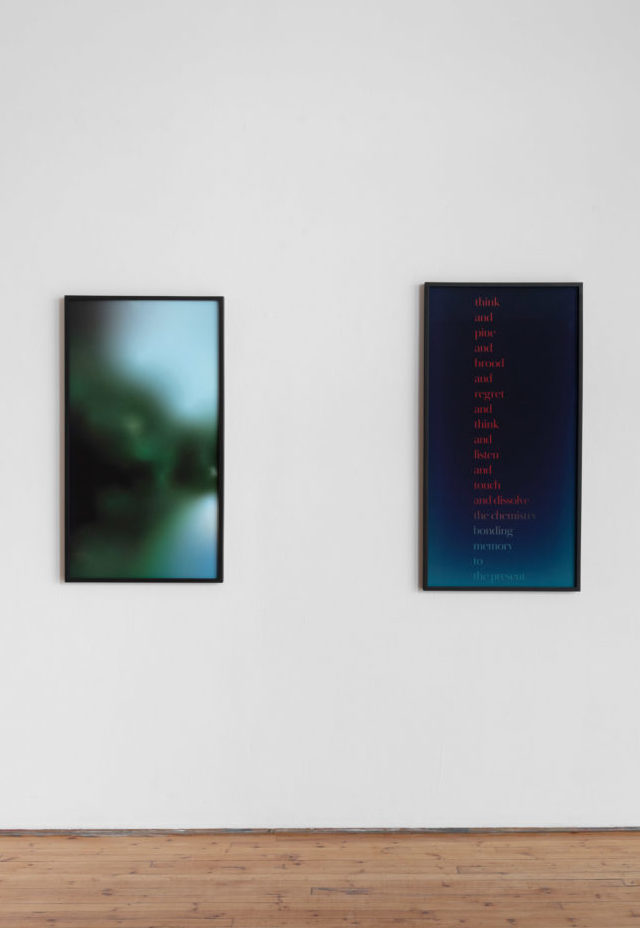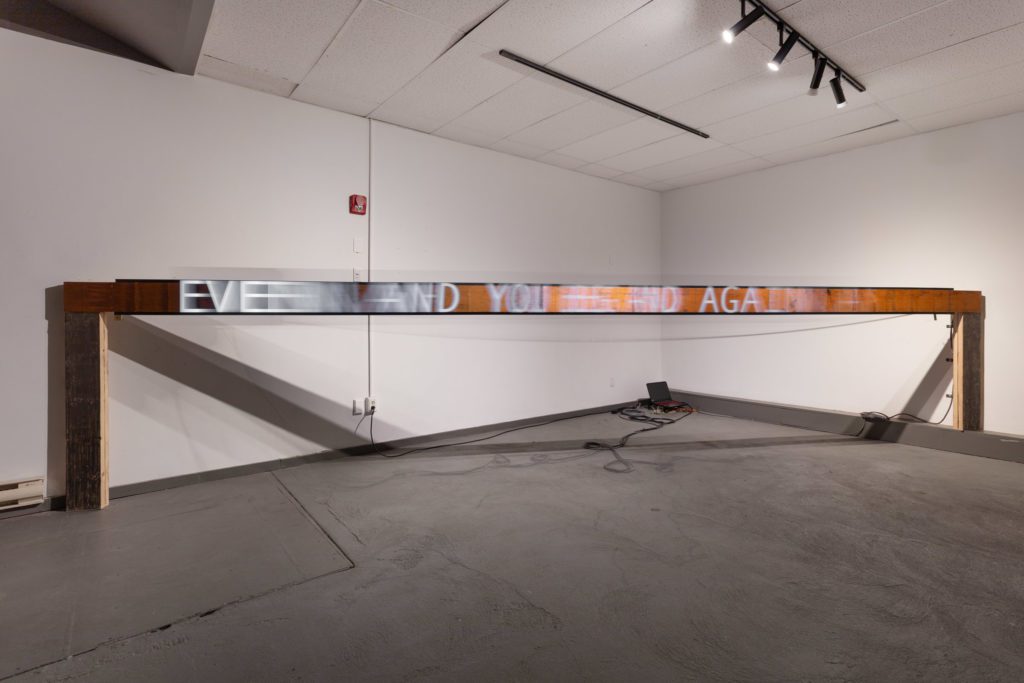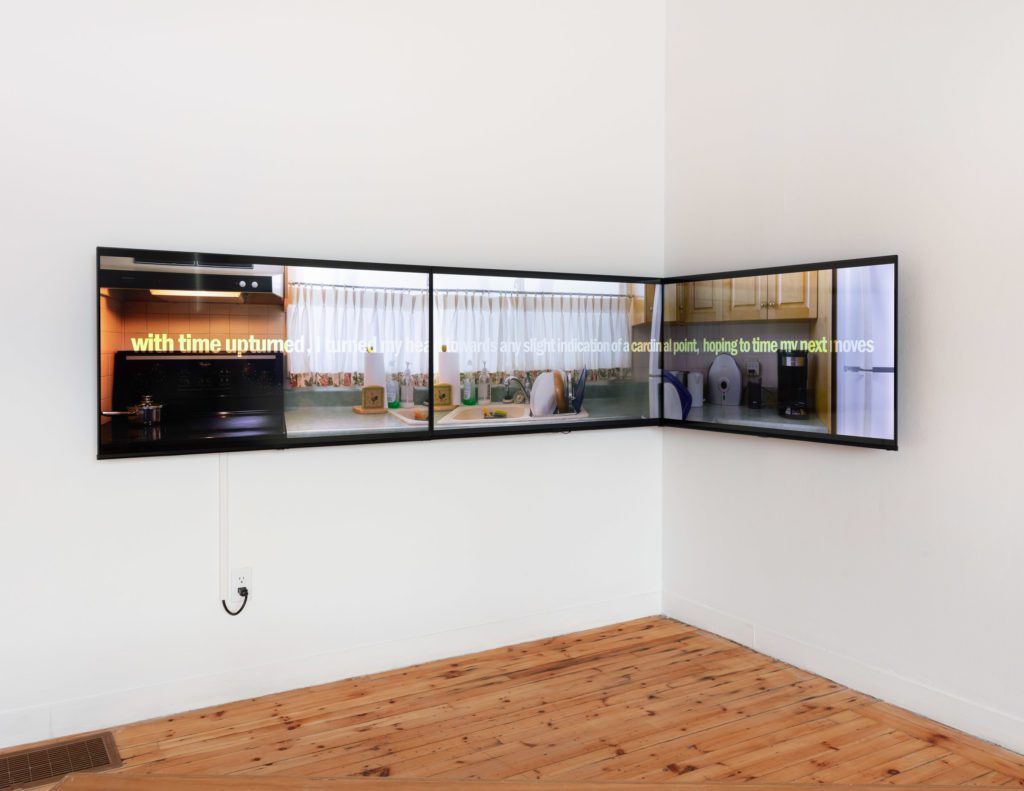A sieve leaking time and place away: José Andrés Mora at Artspace Peterborough
21 November 2022By Yam Lau

On a sunny morning in May, I travelled with José Andrés Mora to his exhibition, The Morning in Reverse at Artspace Peterborough. Passing through the region that day had me ruminating on the petroglyphs at a nearby site that I visited some two decades earlier. The symbols, fissures, and rock substrate that make up the petroglyphs combine to construct a mysterious site-as-text through their entwined material and temporal states. In this environment, the glyphs endure in place and time, endowing everything in the vicinity with an enigmatic significance. The memory of petroglyphs permanently embedded in its geological substrate provides a striking contrast with Mora’s use of text and material support to achieve indefinite effects.
Mora’s text-based practice lodges language within various frameworks of material substrates and manifestations. The texts in the exhibition (all authored by Mora), are made inseparable from their respective visual fields and material supports. Within the exhibition, carefully calibrated intervals between the works introduce parings and dialogues amongst them. Meaning, interpretation, reading, and seeing all conspire to induce a languidly diffuse art-viewing experience. Within the front gallery of Artspace, works on paper are rhythmically placed across the room. Bracketing a corner of this space is Time and Light (2022), a video work displayed on three conjoined monitors, while the back gallery hosts a kinetic text work that is also site-responsive. The work also expands beyond the physical gallery space, where the artist programmed the names of several WiFi addresses into a text work that then transmitted to visitors’ phones. Mora’s installations reflect an astute awareness of site-specificity and vicissitude, both within the works and also in their connection to the environment, while also delivering a world quite opposite to the co-arising of meaning between glyphs, time, and place that are present in the petroglyphs. Time, place, and text evaporate and lose their definitive registers in Mora’s practice.

For example, Habitual Remembrance (2022), installed in the gallery’s sun-filled front room, demonstrates an uncanny rapport with its situation. The writing in this piece is a poetic musing on the way memory compromises the certainty of an idealized present. This text is placed in a gradient field that simulates the effect of photographic overexposure. Here, writing and the gradient are set up to work in a relation of reciprocal supplementation, one that entwines meaning with a field of atmospheric disembodiment. With the text and ground mutually conceding to the other’s conditioning, the resulting image appears to be less than the present. The work is thus experienced by the viewer as dissolving into the afternoon light with the closing line: “I have to forget to remember well.”
Paired with Habitual Remembrance, the work A sunset is a sunrise in reverse. The parenthesis of my day opened, against my will to sleep, before dawn, and would close, against my will to sleep, after dusk (2022), is also installed in the gallery’s front room. The digitally generated work, created by an algorithm that mediates colour fields, is composed of a gradient quadrant divided by a blurred, slightly skewed, cross-like figure. Almost representational, yet lacking any definitive indexical authority, the image loosely approximates a window frame when seen from below. In A sunset…, the lengthy title is given greater significance in juxtaposition to the visual counterpart, in which the written and visual aspects collaborate to supplement the other’s “reality.” Oddly, while indicators of time are mentioned in the text, it is almost futile to pin the exact time of day based on the quality of the fictional light in the image alone, and instead appears to be a time devoid of orientation. Here, the “window” acts like a sort of sieve through which time leaks, while leaving the timeline abstracted. What kind of time is the viewer then presented with? An indefinitely unmoored time? A kind of consciousness that is out-of-sync or barred from identifying with temporal markers, perhaps?

Time and Light (2022) is an animated text/video work which unfolds across three conjoined monitors. The monitors are configured to transpose the image of an L-shaped kitchenette onto the physical environment, forging a correspondence between content and site. The bold text, which reads “turned light into time,” obscures the image behind it. The camera zooms out to reveal a domestic kitchenette, then zooms back in, expanding and contracting the scene in a loop. This repetition marks time in an unremarkable, quotidian way. Mora’s text, animated in an opposing movement, scales down and expands laterally to reveal phrases reserved between the words “turned light into time.” The text and the scene always return to and collapse back onto their inescapable origin: “turned light into time.” The light from the kitchen window does not seem to change, either. Banality persists. Time and Light exchanges its improbable stasis. Time moves, and it doesn’t—development is thus thwarted. One of the expanded lines reads: “the day returned broken, distorted; dispersed by light in every direction, bringing disorder to time and memory.” In Time and Light, the “drama” of a consciousness attempting to grasp and locate itself in time is played out in the substrate of a prosaic image—it is an image of mundane sameness, a place too banal to take note or get a hold of. A place deflated, where nothing happens, except the struggle to register time, memory, and light. One might ask, what is the temporality of an unanchored consciousness, a consciousness that fails to register? And as a corollary, its visual expression?
Mora’s beautiful exhibition offers much to see and experience, even if, paradoxically, some “things” cannot be pinned down, and some even failed to “happen.” Yet the formal integrity of the work is compelling. It elevates the autobiographical and the psychological experiences of time into an articulated visual-temporal modality. While his practice issues from subjective experience, his orchestration of various media, with writing being predominant, performs the mutual conditioning between the subjective and the structural, forging the unique and difficult elements of the subjective into new artistic forms. If the goal of art is to invent new visual and temporal modalities, then Mora’s has succeeded to infuse and ground these with psychological, personal, and existential urgency.
The Mornings in Reverse by José Andrés Mora ran from March 12 – May 14, 2022 at Artspace in Peterborough, ON.
Feature Image: Time and Light, 2022 by José Andrés Mora. Photo by LF Documentation, courtesy of Artspace Peterborough.



